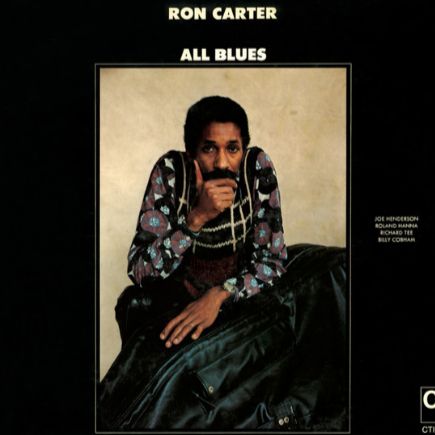Ron Carter: l’architecture subtile d’un maître de la contrebasse
Contrebassiste et violoncelliste américain, Ron Carter occupe une place de premier plan dans l’histoire du jazz moderne. Sa trajectoire, marquée par une exigence artistique constante et une polyvalence rare, en fait une figure incontournable du paysage musical international. Formé d’abord au violoncelle, instrument qu’il abandonne en raison des barrières raciales limitant alors les perspectives pour un Afro-Américain dans les orchestres classiques, Carter se tourne vers la contrebasse et s’impose rapidement comme une référence absolue.
Diplômé de la prestigieuse Eastman School of Music puis de la Manhattan School of Music, il développe une approche du jazz fondée sur une rigueur technique, une imagination harmonique féconde et une intelligence musicale hors pair. Son jeu se distingue par une articulation limpide, un phrasé raffiné et une capacité unique à dialoguer avec ses partenaires de manière organique, toujours au service du collectif.
C’est au sein du Second Quintet de Miles Davis, entre 1963 et 1968, que Ron Carter accède à une reconnaissance internationale. Avec Herbie Hancock au piano et Tony Williams à la batterie, il forme l’une des sections rythmiques les plus inventives et influentes de l’histoire du jazz. Ensemble, ils explorent de nouveaux territoires harmoniques et rythmiques, redéfinissant les règles du jeu avec une liberté novatrice. Les albums E.S.P., Miles Smiles ou Nefertiti témoignent de cette période charnière, où tradition et modernité cohabitent avec une audace sereine.
Après avoir quitté Miles Davis, Ron Carter poursuit une carrière prolifique en tant que leader et sideman. Il enregistre plus de cinquante albums sous son propre nom, tout en collaborant avec une multitude d’artistes de premier plan, parmi lesquels Stanley Turrentine, Lionel Hampton, et bien d’autres. Il participe également au quintette VSOP – aux côtés de Freddie Hubbard, Wayne Shorter, Herbie Hancock et Tony Williams – qui prolonge l’héritage du groupe de Miles dans une veine post-bop raffinée. Il est également membre du Great Jazz Trio, et forme un quartet marquant avec Sonny Rollins, McCoy Tyner et Al Foster.
Ron Carter détient aujourd’hui le record mondial du plus grand nombre d’enregistrements réalisés par un contrebassiste – plus de 2.200 – selon le Guinness World Records. Mais au-delà des chiffres, son apport au jazz repose sur une vision artistique exigeante, une écoute d’une rare acuité et une élégance sonore qui ont profondément marqué l’esthétique de la contrebasse. Par sa constance, son inventivité et son intégrité musicale, Ron Carter a façonné une œuvre durable, à la fois enracinée dans la tradition et résolument tournée vers l’avenir.
Ron Carter: la arquitectura sutil de un maestro del contrabajo
Contrabajista y violonchelista estadounidense, Ron Carter ocupa un lugar destacado en la historia del jazz moderno. Su trayectoria, marcada por una exigencia artística constante y una versatilidad poco común, lo convierte en una figura imprescindible del panorama musical internacional. Formado inicialmente en el violonchelo, instrumento que abandonó debido a las barreras raciales que entonces limitaban las oportunidades para un afroamericano en las orquestas clásicas, Carter se orientó hacia el contrabajo y no tardó en imponerse como una referencia absoluta.
Graduado de la prestigiosa Eastman School of Music y posteriormente de la Manhattan School of Music, desarrolló un enfoque del jazz basado en una rigurosidad técnica, una fértil imaginación armónica y una inteligencia musical excepcional. Su estilo se caracteriza por una articulación clara, un fraseo refinado y una capacidad única para dialogar de manera orgánica con sus compañeros, siempre al servicio del conjunto.
Fue en el seno del Second Quintet de Miles Davis, entre 1963 y 1968, donde Ron Carter alcanzó un reconocimiento internacional. Junto a Herbie Hancock al piano y Tony Williams en la batería, conformó una de las secciones rítmicas más innovadoras e influyentes de la historia del jazz. Juntos exploraron nuevos territorios armónicos y rítmicos, redefiniendo las reglas del juego con una libertad audaz. Los álbumes E.S.P., Miles Smiles o Nefertiti dan testimonio de ese periodo decisivo, donde tradición y modernidad convivieron con una audacia serena.
Tras su salida del grupo de Miles Davis, Ron Carter desarrolló una prolífica carrera como líder y acompañante. Grabó más de cincuenta discos bajo su propio nombre y colaboró con una gran cantidad de artistas de primer nivel, entre ellos Stanley Turrentine, Lionel Hampton y muchos otros. Participó también en el quinteto VSOP –junto a Freddie Hubbard, Wayne Shorter, Herbie Hancock y Tony Williams– que prolongó el legado del grupo de Miles en una estética post-bop depurada. Fue además miembro del Great Jazz Trio, y formó un cuarteto memorable junto a Sonny Rollins, McCoy Tyner y Al Foster.
Ron Carter ostenta hoy el récord mundial del mayor número de grabaciones realizadas por un contrabajista –más de 2.200– según el Guinness World Records. Pero más allá de las cifras, su contribución al jazz se fundamenta en una visión artística exigente, una capacidad de escucha excepcional y una elegancia sonora que ha marcado profundamente la estética del contrabajo. Por su constancia, su inventiva y su integridad musical, Ron Carter ha forjado una obra duradera, enraizada en la tradición y, al mismo tiempo, decididamente orientada hacia el futuro.
Ron Carter: l’architettura sottile di un maestro del contrabbasso
Contrabbassista e violoncellista statunitense, Ron Carter occupa un posto di rilievo nella storia del jazz moderno. Il suo percorso, segnato da un’incessante esigenza artistica e da una rara versatilità, lo rende una figura imprescindibile nel panorama musicale internazionale. Inizialmente formato al violoncello, strumento che abbandona a causa delle barriere razziali che allora limitavano le prospettive per un afroamericano nelle orchestre classiche, Carter si orienta verso il contrabbasso, imponendosi rapidamente come punto di riferimento assoluto.
Diplomato alla prestigiosa Eastman School of Music e successivamente alla Manhattan School of Music, sviluppa un approccio al jazz fondato su una rigida disciplina tecnica, una feconda immaginazione armonica e un’intelligenza musicale fuori dal comune. Il suo stile si distingue per un’articolazione limpida, un fraseggio raffinato e una capacità unica di dialogare in modo organico con i partner musicali, sempre al servizio del collettivo.
È all’interno del Second Quintet di Miles Davis, tra il 1963 e il 1968, che Ron Carter ottiene un riconoscimento internazionale. Insieme a Herbie Hancock al pianoforte e Tony Williams alla batteria, dà vita a una delle sezioni ritmiche più inventive e influenti della storia del jazz. Insieme esplorano nuovi territori armonici e ritmici, ridefinendo le regole del gioco con una libertà innovativa. Gli album E.S.P., Miles Smiles e Nefertiti testimoniano questo periodo cruciale, in cui tradizione e modernità convivono con un’audacia misurata.
Dopo aver lasciato Miles Davis, Ron Carter intraprende una carriera prolifica come leader e sideman. Registra oltre cinquanta album a suo nome, collaborando al tempo stesso con una moltitudine di artisti di primo piano, tra cui Stanley Turrentine, Lionel Hampton e molti altri. Partecipa anche al quintetto VSOP – insieme a Freddie Hubbard, Wayne Shorter, Herbie Hancock e Tony Williams – che prosegue l’eredità del gruppo di Miles in una raffinata vena post-bop. È inoltre membro del Great Jazz Trio e forma un quartetto di rilievo con Sonny Rollins, McCoy Tyner e Al Foster.
Ron Carter detiene oggi il record mondiale per il maggior numero di registrazioni realizzate da un contrabbassista – oltre 2.200 – secondo il Guinness World Records. Ma al di là dei numeri, il suo contributo al jazz si fonda su una visione artistica esigente, un ascolto di rara acutezza e un’eleganza sonora che ha segnato in profondità l’estetica del contrabbasso. Con la sua costanza, la sua inventiva e la sua integrità musicale, Ron Carter ha costruito un’opera duratura, radicata nella tradizione e al contempo proiettata verso il futuro.
Ron Carter: the subtle architecture of a master bassist
An American double bassist and cellist, Ron Carter holds a prominent place in the history of modern jazz. His journey, marked by unwavering artistic rigor and rare versatility, has made him a key figure in the international music scene. Initially trained as a cellist, Carter abandoned the instrument due to the racial barriers that restricted opportunities for African Americans in classical orchestras at the time, turning instead to the double bass, where he quickly established himself as a definitive reference.
A graduate of the prestigious Eastman School of Music and later the Manhattan School of Music, he developed a jazz approach grounded in technical precision, fertile harmonic imagination, and exceptional musical intelligence. His playing is distinguished by its crystal-clear articulation, refined phrasing, and a unique ability to interact organically with fellow musicians—always in service of the ensemble.
Carter rose to international fame as part of Miles Davis’s Second Quintet between 1963 and 1968. Alongside Herbie Hancock on piano and Tony Williams on drums, he formed one of the most inventive and influential rhythm sections in jazz history. Together, they explored new harmonic and rhythmic frontiers, redefining the rules with bold creativity. Albums like E.S.P., Miles Smiles, and Nefertiti capture this pivotal period, where tradition and modernity coexist with quiet audacity.
After parting ways with Miles Davis, Ron Carter pursued a prolific career as both leader and sideman. He recorded over fifty albums under his own name and collaborated with numerous major artists, including Stanley Turrentine, Lionel Hampton, and many others. He also joined the VSOP Quintet—alongside Freddie Hubbard, Wayne Shorter, Herbie Hancock, and Tony Williams—which extended the legacy of Miles’s group in a refined post-bop vein. Additionally, he was a member of the Great Jazz Trio and formed a notable quartet with Sonny Rollins, McCoy Tyner, and Al Foster.
Ron Carter currently holds the world record for the most recordings by a bassist—over 2,200—according to Guinness World Records. Yet beyond the numbers, his contribution to jazz is rooted in a demanding artistic vision, an exceptional sense of listening, and a sonic elegance that has deeply influenced the aesthetics of the double bass. Through his consistency, inventiveness, and musical integrity, Ron Carter has shaped a lasting body of work—firmly grounded in tradition, yet unmistakably forward-looking.


Autres articles – Otros artículos – Altri articoli
Styles de jazz – Estilos de jazz – Stili di jazz – Jazz Styles
More Than You Know–28.02.1961–Coleman HAWKINS
I Fall In Love Too Easily–16.04-17.04.1963–Miles DAVIS
Autumn Leaves–27.07.1963–Miles DAVIS
My Funny Valentine–12.02.1964–Miles DAVIS
Night And Day–06.05.1964–Stan GETZ & Bill EVANS
Misty–27.05.1964–Bob BROOKMEYER & Stan GETZ
Love For Sale–30.08.1965–Eddie HARRIS
Wave–09.04-10.04.1977–Alfred McCOY

